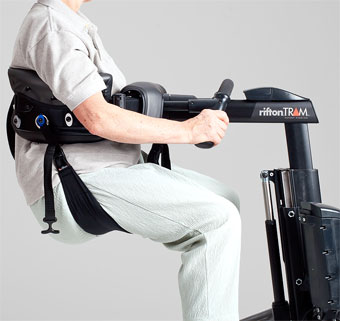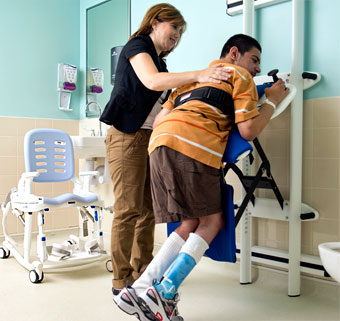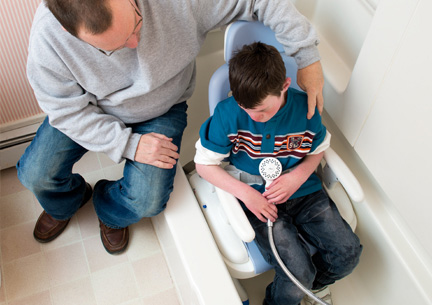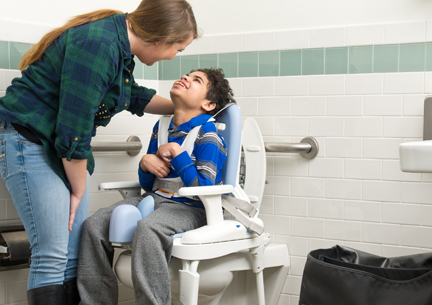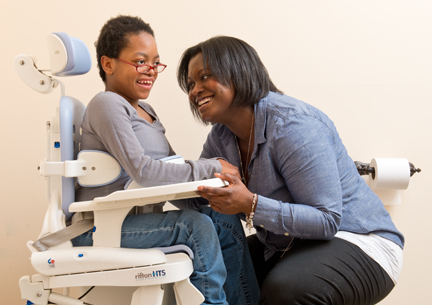Toileting Transfer Tips for Individuals with Muscular Dystrophy
Using the Rifton TRAM for Someone with Low Tone
| December 2016Transferring someone with low tone and little or no weight bearing to and from the toilet is challenging. Along with a dependent lift, a therapist must guard against the individual slipping down or sagging during the seat-to-seat transfer in addition to managing clothing. Even with lifting devices it is difficult to execute a smooth, dignified, safe transfer with an individual unable to maintain any degree of muscle tone.
Because the Rifton TRAM, a transfer and mobility device, is used regularly for seated transfers, we frequently field questions on how best to configure the device for just such a demanding scenario.
One school therapist we know has been working with the TRAM and a 20-year old student with muscular dystrophy for over three years. Together they came up with a great method for a successful toilet transfer, and we think others might benefit from these ideas.
Steps for Toileting an Individual with Muscular Dystrophy
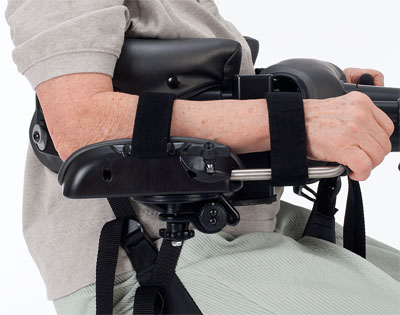
Tips before starting:
- Position the TRAM body support system as low as possible on the trunk and tighten it as much as tolerated to prevent it from riding up during the seated transfer.
- Position the forearm supports of the TRAM directly under the shoulder girdle and slightly forward. This allows the individual to lean down onto them, off-weighting part of the body weight.
Next, follow these steps:
1. While the individual is seated in the wheelchair, hook the front rings of the two thigh straps onto the yellow clips in the front. Then cross the straps before threading underneath the individuals thighs and attaching the rear strap ring onto the blue or grey clips in back.
2. Raise the TRAM and maneuver it in front of toilet. Lower the TRAM so the individual is seated on the toilet, fully clothed.
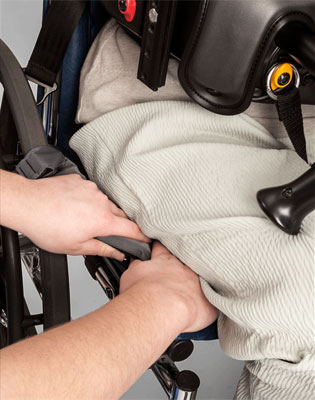
3. While the individual remains seated on the toilet and secured in the body support, remove the thigh straps.
4. Raise the individual a few inches off the toilet to give just enough clearance for quickly doffing the clothing. (Feet remain on the floor and weight-bearing is encouraged both through the lower extremities and through the arms on the forearm prompts).
5. When clothing adjustment is complete, return the individual to the toilet and release the trunk support for comfort.
6. After toileting, make sure body support system is secure and the individual’s feet are on the floor. Raise the TRAM a few inches while encouraging weight-bearing and quickly readjust the clothing. Return to toilet seat.
7. When the individual is seated, attach the thigh straps as before.
8. Raise the individual up from the toilet and return to wheelchair.
Additional Resources for Toileting with the TRAM
For non-ambulatory individuals with contractures or high tone, these case studies on toileting with the TRAM are helpful.
Compiled by a NYC school therapist, here is a detailed step by step guide for prepping and using the Rifton TRAM for toileting.
